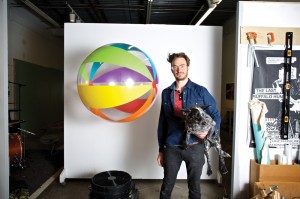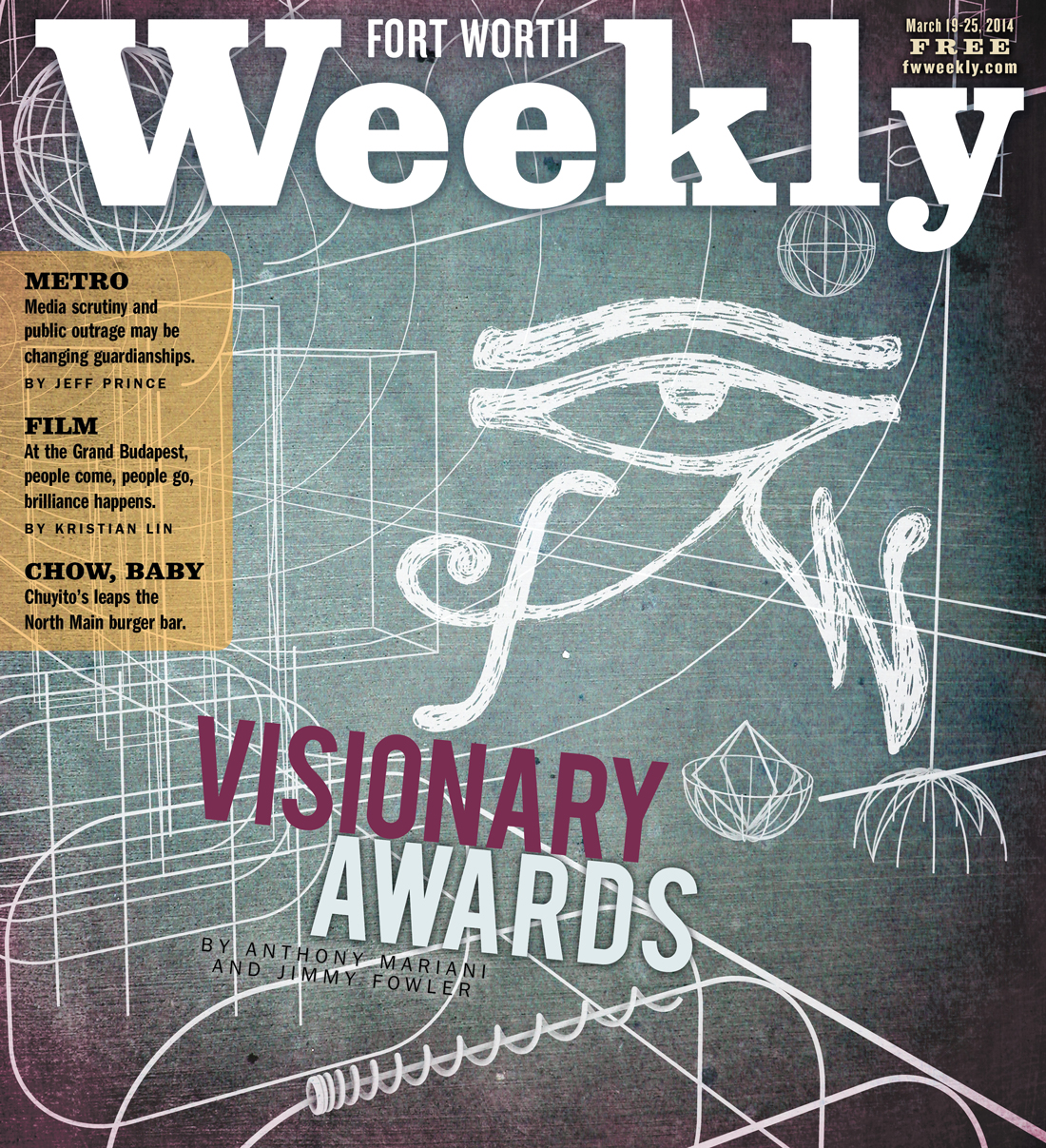Fort Worth Weekly is not an advocacy mag, unless you consider exposing sources of anti-truth, anti-liberty, and anti-justice some sort of biased mission. But we do enjoy pointing readers in the right direction. For more than 15 years we’ve been turning Fort Worthians on to the best music in their backyard via our pages and our annual Music Awards Festival, a free all-day block party whose most recent incarnations have featured 48 bands (all from Tarrant County) in six venues. And for the past four years, we’ve been celebrating the best local visual artists, actors, directors, and more through our Visionary Awards.
Created simply to give back, the Visionary Awards include a $500 cash prize per winner and, of course, some publicity, a hot commodity in a media market dominated by Dallas and by touring events and personalities. For our 2014 edition, our nominating committee (comprising nearly 30 local art-world folks) did something unprecedented and chose a theater person, Adam Adolfo, as a recipient. “That’s very humbling,” Adolfo said. Joining the producer/director as winners this year are multimedia artist Bradly Brown and the 13-member art collective HOMECOMING! Committee. All three winners join previous Visionaries Michelle Brandley, Lauren Cross, Andrew Disney, Tim Harding, James Lassen, David Patrick Lowery, Frank Mosley, Devon Nowlin, and Micah Yarborough as representatives of some of the best, most progressive art coming out of the great 817. And going … beyond.
The 2014 winners will be feted from 6 to 9 p.m. on Thursday, April 17, at Artspace 111 (111 Hampton St., 817-692-3228) –– admission is $20 per person or $30 per couple and includes free booze and food. (We’ve done the math, and three hours of partying at any other place in town is going to cost you a lot more than what we’re offering.) Get your tickets now at Spunetickets.com.
Congratulations again to Adam Adolfo, Bradly Brown, and HOMECOMING! Committee –– and to all of you for your readership and support. See ya April 17 at Artspace. –– A.M.
Bradly Brown
In 2002 at Conduit Gallery in Dallas, amid walls that had been tiled with cyanotype yearbook portraits of children printed on carpet, sat two student desks, their rigid contours at play with the shadows from the dim lighting. One desk was half-buried beneath a mound of beige pencil shavings, the other embedded like pins with 444 sharpened No. 2 pencils. Hanging on the wall in front of the desks was a chalkboard with a blue arc stretching across a simple map of the Earth. Though Bradly Brown had participated in several group shows as a young artist, 15,540 Miles –– or the distance that can be drawn by 444 No. 2 pencils, assuming the lead in each lasts for precisely 35 miles –– was his first solo exhibit. “It was about motivating or about getting completely piled on top of,” he said. “That show defined the path that I continued to pursue to today.”

Brown was just wrapping up his photography degree from the University of North Texas and essentially had to scramble to take advantage of the opportunity to exhibit at Conduit, one of the most prestigious and forward-thinking galleries in Texas.
He got the Conduit gig through an open call for artists to show at the now-defunct Art Bar in Deep Ellum. “It’s a bar, but at the time, I’d show anywhere,” Brown said. “If you put my stuff up on the wall, it’s good.”
Brown’s Art Bar submission, creepy theatrical photos of young men in barnyard animal masks, impressed the curator, Danette Dufilho, who promptly arranged an interview for Brown with Nancy Whitenack, Conduit owner and director. “I came in and showed [Whitenack] some things,” Brown recalled, “and she was like, ‘Uh, nope. Sorry. Come back to me with a plan.’ ”
Brown returned to his studio and thought about the gallery space, how the room worked, and what he could do with it. A week later, he returned to Conduit with 15,540. “I said, ‘OK, this is going here, this is going there. I wanna do this, this, and this.’ And [Whitenack] was like, ‘Great. Let’s do it.’ ”
The experience, like the show itself, has stuck with Brown. “That’s a huge thing that I think younger artists need to learn, that when that opportunity arises, you’d better jump on it,” he said. “It comes and goes very quickly.”
Brown hasn’t let many opportunities pass him by since then. A recent graduate of the master’s program at Texas Christian University, where he has been teaching for two semesters, the 34-year-old El Paso native is one of the brightest lights in North Texas’ burgeoning conceptual art landscape. His work pivots on the intoxicating combination of headiness and lightheartedness. One of his most memorable pieces is “Attention Retention,” three everyday multicolored beach balls held aloft by three strategically placed electric fans. Another novel composition is Beastly Words, a series of drawings of objects (a zebra, a tiger, track runners, a WWII fighter plane) using film negatives of printed words recovered from a university trashcan.
Christina Rees, curator of Fort Worth Contemporary Arts, has been a Brown fan for years. Brown, she said, “is a rare combination of worldly and humble. He’s incredibly sophisticated due to his intellectual curiosity but also, obviously, his years living in New York City as a professional artist, musician, and designer. But he never trumpets his past achievements. That’s his wisdom.”
Brown grew up in an art-loving upper-middle-class family, the younger of two children. His father was an architect and his grandfather made custom dress shirts for Mafiosi in New York City. “At least that’s the legend,” Brown said with a chuckle.
Brown developed an affinity for art at an early age. Instead of being enraged after young Bradly had drawn all over the walls in the house and colored his stuffed animals, his parents encouraged him. “That’s a huge reason I am where I am,” he said.
As a teenager, Brown became heavily involved in playing music, specifically proto-punk rock. “Being in a band [was] to get girls, basically,” he said.
Along with The Velvet Underground records that his older sister turned him on to, Brown was also influenced by “slowcore” artists such as Slowdive, Jawbox, and My Bloody Valentine and also early emo music (Built to Spill, Cap’n Jazz, Joan of Arc, anything from Thrill Jockey Records). A drummer with no formal training, Brown found a home in the El Paso music scene.
“I went to several different schools,” he said. “My social community was completely based out of the music scene … which was very strong and supportive and close” and which produced one of the biggest bands of its kind in the country, At the Drive-In.
Brown continued pursuing music after relocating to Denton, whose still-exciting scene was one of the reasons he chose to attend UNT. His de facto headquarters was Rubber Gloves Rehearsal Studios, whose owner, Josh Baish, is from El Paso and had gone to high school with Brown’s sister. Brown eventually worked his way up from janitor to bartender. “That was a great saturation in creativity and music and people I wanted to be around,” Brown said.
He chose to study photography as opposed to painting or sculpture based on experiences with film in his high school’s darkroom and the influence of an art teacher, LeeAnn Needham. “She … opened me up to a lot of artists who made me understand what art was,” Brown said. “She removed it from pretty pictures on a wall and put it into a conceptual world, so … it was something I gravitated toward pretty quickly, and I really enjoyed the experience in the darkroom. I really enjoyed the chemicals and the process. I love process in my artwork and in the artwork I like, and so I felt like I gravitated toward that because of the darkroom.”
There also were practical implications to Brown’s photography-major decision. “I thought it could be a creative field that would also allow me to get a job,” he said. “I was also interested in hybrid forms as an art medium, so I thought if I could become a solid photographer, then I could document a lot of this work that was ephemeral, fall-apart, temporary. Photography felt like a really good fit.”
Brown, who said he had great professors at UNT, got an internship and then a job at Greg Booth & Associates in Dallas, a commercial photography firm, where he learned more in his first month as a photo assistant than he did during multiple semesters at school. His photography classes, he said, were more about “what you were shooting, not necessarily the technical aspects of it, and being [a photo] assistant was just all technicality, a very quick crash course in learning, which was awesome.”
Around graduation, Brown had become deeply involved with his band at the time, Oceanographer. And with “very little” money in his bank account, he and his four bandmates packed up, picked up, and relocated to Brooklyn. “We all just decided to move up there together and see what happens,” Brown said.
After about four years in New York, Brown, who had been working as a designer and art director for various record labels, began to lose interest in music. “When you’re in New York, you need to have very tight priorities, and you need to figure out what’s most important to you and keep those things under control,” he said. “We played a lot. We had some amazing opportunities and shows, and I would never give up those experiences, but I was more interested in following [art], and [the band] became less important to me.”
Working in the music industry reinforced his decision. “Seeing how the music industry worked, eh, I wasn’t really into it,” he said.
Having always wanted to teach, Brown chose to pursue his MFA at TCU after chatting with a trusted friend who was in the program at the time and loving it. “I knew there was a community that I was familiar with and that was established and respected,” Brown said.
He also had other reasons for leaving the City That Never Sleeps. “I wanted to get out of New York just because I felt like I had done it,” he said. “I wanted a backyard and a dog and a truck, a better quality of life.”
He didn’t fully leave New York behind, though. One of his strongest artistic experiences occurred in Ace Gallery in Soho. It was Los Angeles artist Tim Hawkinson’s “Überorgan,” a sprawling, towering, fully automated bagpipe. “That show’s always kind of stuck with me,” Brown said, “like, ‘Oh, crap. People are doing that?! That’s your competition, basically. You’re kind of screwed.’ ”
“Überorgan” and similar conceptual masterpieces that Brown viewed in New York inspired him to concentrate on sculpture at TCU. “I think that with a lot of my work, there’s no medium it’s based in,” he said, “so I think ‘sculpture’ is a good catchall for that.”
At TCU, Brown started a quarterly magazine, Semigloss (“Sparkling Prose,” Jan. 22, 2014), with Dallas artist Sally Glass and co-founded HOMECOMING! Committee, the art collective that also is a 2014 Visionary Award winner. He started teaching almost immediately after graduation. “I love teaching,” he said. “You get people from all over the school, which is kind of cool.”
Brown was recently awarded a $5,000 scholarship from Mercedes-Benz Financial Services. After opening a Fort Worth location in 2008, the Michigan-headquartered company created a joint partnership with the art schools of TCU and Southern Methodist University to honor one student from each program annually, beginning this year. Along with six pieces from SMU’s winner, junior Diana Antohe, two of Brown’s artworks are now on display in the company’s building near Alliance Airport.
“Purification Station” is a fully functioning water filter composed of vibrantly colored buckets, cinder blocks, sand, gravel, charcoal, and a glass vase. Resembling a large, prismatic totem, the artwork suggests “the commodification of an object meant to be scraped together using commonly found items,” Brown wrote in his artist’s statement. “I altered cinder blocks and buckets to reflect a contemporary pop aesthetic, as if it were something that could be bought at a retail outlet like Target.”
His other Mercedes-Benz piece is “Transpacific (a line drawn from Texas to Japan),” an assemblage of the word “Chorioactis” written in cursive white letters on blackened paper, suspended above a pile of pencil shavings on the floor and, on a shelf, 194 No. 2 pencils reduced to nubs. Created for an exchange program between TCU and Hiroshima City University, “Transpacific” is not as much about visual audacity –– striking though it is –– as it is about context. The mushroom Chorioactis, known as “the devil’s cigar” or “Texas star” in the United States, is found only in select locales in Texas and Japan. “This piece of endurance is meant to reflect the distance traveled by the mushroom’s spore cloud between the two countries, mirrored by the movements of my hand,” he wrote.
Along with preparing for two group shows as part of the Dallas Biennial this spring, Brown is settling in to a new living arrangement. He’s become the caretaker/manager of an artists’ facility in River Oaks. Owned by Fort Worth multimedia artist and TCU art professor Sally Packard, the house is divided into living quarters and studios. “An idea I’ve always wanted to do is open up these communal spaces for artists, you know, having … a woodshop, a foundry, a photo studio that people can rent, and studio spaces,” he said. “I think this has been a way to get some experience in that.”
In New York City, you’ve basically got to be a billionaire to have your own studio. Not so in Fort Worth. “I don’t think it matters where you live as long as you’re doing something interesting,” he said. “But in comparison, Fort Worth has a ton of inexpensive property that allows for amazing studio space. I think both cities have pluses and minuses, but it’s more interesting to me to work in a place like Fort Worth because it has such a young contemporary art scene, and it feels like you can be part of its development.” –– A.M.












